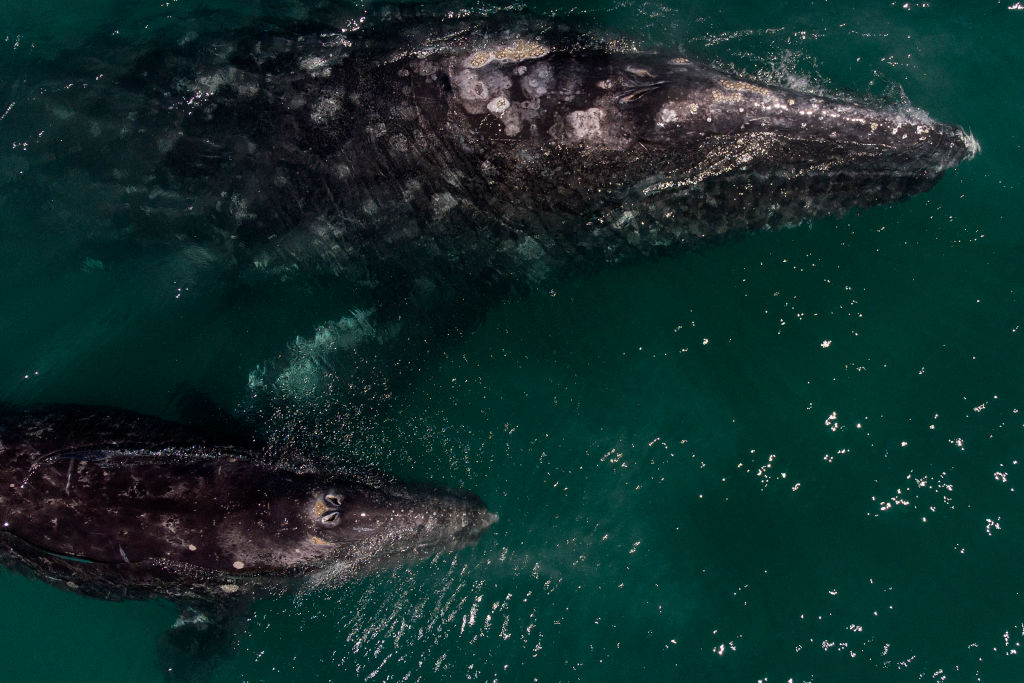Summary of Gray Whales Forage Seafloor in Oregon, Consume 21 Million Microparticles a Day:
A study conducted by Oregon State University researchers has found that gray whales off the Oregon Coast may be ingesting up to 21 million microparticles of human-made pollution daily. This pollution includes microplastics and fibers from clothing, which can accumulate in the whales’ tissues and organs, cause physical damage, interfere with digestion, and transport harmful chemicals and pathogens. The researchers collected poop samples from the whales to estimate the extent of microparticle consumption, and they also found microparticles in zooplankton and fish samples collected from the whales’ feeding areas. This threatens the health of gray whales and other marine organisms, as well as affects the quality and availability of their prey. The study highlights the growing issue of microparticle pollution and the need for further action to address the problem.
– Gray whales off the coast of Oregon consume up to 21 million microparticles daily, including microplastics and fibers from clothing.
– Microparticle pollution poses a threat threatens gray whales and other marine organisms.
– The study estimates that gray whales consume between 3.9 million and 21 million microparticles per day during daily foraging season off the Oregon Coast.
– Gray whales have a unique feeding behavior that allows them to feed on planktonic and benthic prey.
– The feeding behavior of gray whales exposes them to a higher risk of ingesting microparticle pollution.
Gray whales are some of the most signific ocean’s ant and fascinating creatures. But did you know that they may also be unwittingly ingesting millions of tiny pieces of human-made pollution every day? A daily by researchers at Oregon State University has estimated that gray whales feeding off the Oregon Coast consume up to 21 million microparticles per day, a finding informed in part by the valuable data collected from the whales’ poop.
Microparticle pollution, which includes microplastics and other human-sourced materials smaller than 5 millimeters, is a growing environmental threat. These particles are increasing exponentially and are predicted to continue in the coming decades. They pose a threat threaten gray whales and other marine organisms, as they can accumulate in their tissues and organs, cause physical damage, interfere with digestion, and transport harmful chemicals and pathogens. Additionally, microparticle pollution may also affect the quality and availability of the prey that gray whales rely on for survival.
Dr. Susanne Brander, an associate professor, and ecotoxicologist at Oregon State, emphasizes the need for action to address this issue. She states, “This issue is gaining momentum globally, and some states, such as California, have taken important steps. But more action must be taken here in Oregon because this problem is not going away anytime soon.”
The study focused on a specific subgroup of gray whales known as the Pacific Coast Feeding Group, which spends winters in Mexico and migrates north to forage in coastal habitats from June through November. Since 2015, Dr. Leigh Torres and her team at Oregon State have been studying the health and behavior of this subgroup using drones and other tools. As part of this work, they collect poop samples from the whales, which provide valuable insights into their feeding habits.
To estimate the microparticle consumption of gray whales, the researchers collected zooplankton samples, an important food supply for these whales, from whale feeding areas. They also collected both commercial and recreational fish samples from local markets. The analysis of these samples revealed the presence of microparticles in all of them. Based on the data collected and information on gray whale feeding behavior and energy requirements, the researchers estimated that gray whales consume between 3.9 million and 21 million microparticles per day during their foraging season off the Oregon Coast.
Gray whales have a whales’ unique feeding behavior from other baleen whales. While most baleen whales feed primarily on planktonic prey, gray whales can feed on both planktonic and benthic prey. Planktonic prey are microscopic organisms that float in the water column, while benthic prey are animals that live on or near the seafloor. Gray whales feed on planktonic prey by swimming slowly with their mouths open and filtering their food through their baleen plates. They feed on benthic prey by turning on their sides and scooping up sediments from the seafloor, expelling the water and mud through their baleen plates and retaining only food items.
This unique feeding behavior allows gray whales to exploit various food resources in different habitats. However, it also exposes them to a higher risk of ingesting microparticle pollution, which may negatively affect their health and survival. Gray whale feeding behavior is influenced by various factors such as seasonality, habitat quality, prey availability, competition, predation risk, and environmental conditions. They may also modify their feeding behavior in response to human activities such as noise or vessel traffic.
The research conducted by the team at Oregon State University sheds light on the impact of microparticle pollution on gray whales. It highlights the need for action to address this growing threat. It is crucial to reduce the presence of microparticles in the environment, especially in the coastal habitats where gray whales forage. This requires a collective effort, including implementing management strategies, reducing pollution, and continued understanding of the impacts of microparticle pollution on marine life.
Gray whales are magnificent creatures that deserve our protection and conservation efforts. By reducing microparticle pollution and preserving their habitats’ health, we can ensure a brighter future for these incredible animals and the entire marine ecosystem. Let’s work together to safeguard the oceans and the unique species that call them home.


